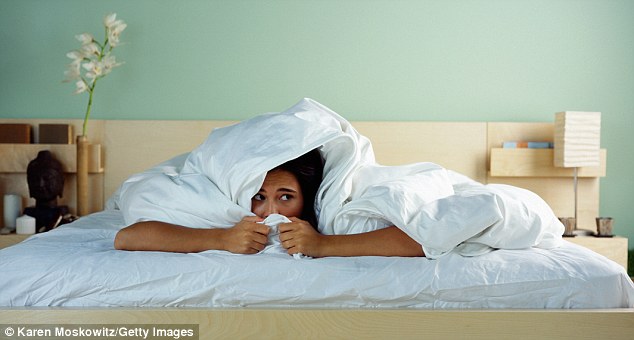One of the clearest characteristics of anxiety disorders (as opposed to ‘just’ anxiety) is the layering of worries, one on top of each other, with the worry about worry being the greatest problem of all
Imagine waking up, every morning, with the sense that something terrible is about to happen.
Everything you need or want to do has some kind of fear and anxiety attached to it: you start to panic about the dangers of getting on the tube; during the course of your journey, you battle dizziness and hyperventilation; it’s hard to swallow and there’s a crushing feeling in your chest.
That’s what life was like for Natalie Lobel, 35, after a shocking cancer diagnosis in summer 2011 left her in what she describes as a ‘heightened state of near-constant fear’, otherwise known as generalised anxiety disorder (GAD).
It’s a condition that affects one in 20 of us at some point during our lifetime, according to Anxiety UK (anxietyuk.org.uk), a charity that supports those living with problems of this sort.
‘It was horrendous,’ Natalie says. ‘I spent a lot of time irrationally wondering whether I’d choke on my breakfast, trip over the cat and break my neck, or if someone had murdered my family.’
An overwhelming anxiety triggered by a cancer diagnosis is one thing, but that the anxiety itself continued long after she went into remission (deemed a medical miracle by doctors in May 2012) seemed unfair, to say the least.
‘I should have been euphoric, singing from every rooftop in London, but instead I felt awful. I might have won a battle but the war was just beginning.’
The war that Natalie refers to – GAD – is defined by Dr David Baldwin, professor of psychiatry at Southampton University, as ‘an excessive and persistent worrying that is hard to control, accompanied by psychological symptoms such as apprehensiveness and irritability, and physical symptoms such as excessive perspiration, tremor and stomach upset.’
That sounds remarkably familiar. I’m sure I’ve felt all of those things in the nights preceding my university finals, or the moments before a job interview, or even a first date. So what turns regular anxiety into something far more severe?

‘I always advise my clients to spend time every morning getting in touch with how they feel in that particular moment with this simple mindfulness exercise,’ says therapist Beth Burgess
‘Differentiating GAD from “normal” anxiety is a question of establishing the severity and duration of symptoms,’ says Baldwin.
‘If symptoms are present without associated stressors [that exam, that first date], feel greatly out of proportion, or persist for long periods, cause substantial personal distress and interfere with everyday function, even after stressors [such as Natalie’s cancer] have gone, thought should be given to the possible presence of GAD.’
‘I yearned to wake up without a sense of impending doom,’ Natalie recalls. ‘To sit in a meeting with colleagues without the feeling that the walls were collapsing in on me, or to not jump out of my skin at a loud noise.’
What Natalie describes is, without doubt, fairly extreme. You might think you’re just ‘a worrier’, but it’s possible there’s something more serious going on. So how do you know?
Anxiety specialist Beth Burgess (smyls.co.uk) suggests one of the clearest characteristics of anxiety disorders (as opposed to ‘just’ anxiety) is the layering of worries, one on top of each other, with the worry about worry being the greatest problem of all.
‘All anxiety disorders are a chicken-and-egg thing, because they’re self-perpetuated,’ she says.
‘You’ll start to feel anxious about something, then you’ll have negative thoughts about it, then your heart might beat a little faster. This might lead on to worries about your general health and fears about going to the doctor.
'Perhaps you’ll start worrying that you’re not coping and that you might have a breakdown.
'Additionally, if you worry excessively about an event that hasn’t happened yet, you’re storing that association in your memory, so the next time you encounter the same situation, you may automatically feel fearful, even if there is no reason to worry.’
Worrying about worrying is a classic sign of GAD. It’s a condition more common in women than men, according to Anxiety UK, and, on average, sets in at around the age of 30.
But why? Most obviously, it’s at this age that women typically take on extra responsibilities such as marriage and having children.
And, according to a report in The Practising Midwife journal, Being Fit in Pregnancy, by Deborah Hazeldean: ‘Estimates suggest that one in three women experiences some form of anxiety or depression [during pregnancy]’ (though many pregnant women experienced less insomnia, stress, anxiety and depression when they exercised, according to the Royal College of Obstetricians and Gynaecologists).
'But perhaps there’s also something intrinsic to women that makes us worry more?
‘When men are exposed to fear, the brain centre that is most likely to be triggered is an action-taking part, while things that cause fear in females are linked to brain centres that control bodily mechanisms such as heart rate and blood pressure,’ says Burgess.
‘Put simply, men are more geared to “fight” and to tackle their problems head-on, whereas women are more geared up to the “flight” response, so they are more likely to freeze up and just worry, or run away and not deal with their issues.
'Additionally, women will add all sorts of emotional meanings to their problems that men don’t.
'Very generally, for a man, a problem is simply a problem and he will start seeking a solution.
'For a woman, a problem may be further complicated by thoughts that she’s a bad mother, a failure in life or not as good as her friends.’

Acknowledge your feelings, accept them and recognise how they may colour your day. Breathe into any unpleasant feelings, softening your belly slightly, to soothe them
And, arguably, there’s a broader sociological element here, too, says Burgess.
‘I think we’re living in an era when the pressures on us are greatest and yet we’re expected to perform better than ever.
'We don’t have communities where people support each other; it’s more of an individualised society and women are juggling careers and children.
'You have to be seen to be doing well, even if you’re not, and that makes you more anxious.’
Then there are hormones. Anybody who’s ever experienced nasty PMT will know how powerful these can be, but for 57-year-old Susan Irwin, the onset of the menopause caused hormonal fluctuations that resulted in ‘horrendous’ stress and anxiety levels.
‘It led me into a very dark place which resulted in me having an emotional breakdown.
'I felt as though I was in a bubble, looking in on myself, and then, one night, when I got into bed, the anxiety overload kicked in and my body and mind were so exhausted that I found myself shaking from head to toe,’ she says.
‘The doctors offered counselling and antidepressants, but I was sure it was a hormonal imbalance so did some research and got the herbal remedy agnus castus [which is commonly used to counter the effects of hormonal disturbances].
'Within hours of taking it I could feel the dark cloud lifting and eventually began to see a light at the end of the tunnel.’
Such a swift reaction is likely to have been a ‘placebo effect’ says Shabir Daya, pharmacist at Victoria Health, who suggests that while this herb ‘allows the body to manufacture progesterone’, and hence achieve hormonal balance, ‘this process can take around eight weeks’.
He recommends also considering the (non-drowsy) magnolia rhodiola complex as ‘there is sufficient data to suggest that magnolia extracts do help to physically relax muscles and nerves and reduce levels of the stress hormone cortisol, which promotes anxiety, nervousness and numerous other concerns in the body’.
And what about pharmaceutical drugs? Patients with ‘distressing and impairing’ anxiety symptoms ‘may well benefit from pharmacological treatment.
'The most commonly prescribed drugs for treating GAD are the selective serotonin reuptake inhibitors (SSRIs) such as Sertraline or Escitalopram,’ says Dr Baldwin, but ‘the proportion of people who respond to an SSRI is similar to the proportion who respond to psychological treatments such as cognitive behavioural therapy or applied relaxation’.
Such ‘applied relaxation’ techniques include regular meditation, a technique that’s said to effectively train the brain to work in a different, less anxiety-prone way.

Richard Davidson and his team at the Laboratory for Affective Neuroscience at the University of Wisconsin found that eight weeks of mindfulness increased left-sided prefrontal activation, which is associated with more adaptive responses to negative or stressful life events (an ‘adaptive response’ to the loss of a loved one would be remembering the good times you had as part of working through the grief, whereas a ‘maladaptive’ response would be to try to block out the grief by going on a drinking binge).
‘The truth is that, just like any other emotion, anxiety is neither good nor bad,’ says Andy Puddicombe, mindfulness teacher and founder of Headspace (headspace.com).
‘It begins with a passing thought, nothing more, nothing less.
'Ultimately, it is we ourselves who make the choice as to what to do with that passing thought, how much importance to give it and how long we choose to hold on to it for.
'Sure, it doesn’t feel like that at first, because the habit is so strong, but this is the potential.’
Along with the amazing levels of support she received from the Net Patient Foundation (netpatientfoundation.org) throughout her cancer treatment, Natalie used various methods, including meditation, reflexology and hypnotherapy, to try to reduce the anxiety that raged inside her. But it wasn’t until late 2013 that things really began to shift.
‘Out of the blue when I woke up, my first emotion wasn’t dread.
'Then I noticed that I could do things I used to take for granted – take public transport, spend more than five minutes in a supermarket, talk to strangers and not feel as though I was about to collapse with fear.’
In Natalie’s case, time was the biggest healer of all and, with help and support from professionals, family and friends, she says she can ‘see more clearly now.
'If someone had told me at the beginning of last year that I would be able to, truthfully, say that anxiety no longer rules my roost, I wouldn’t have believed them,’ she says.
‘I don’t feel the need to solve my “anxiety problems” any more, I just try to wait and see what each day will bring.’







Comments